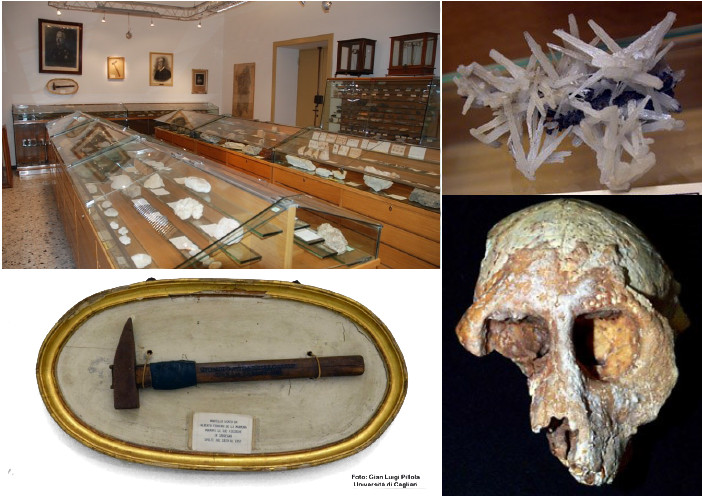
Museum of Mineralogy “Leonardo De Pruner” and Sardinian Museum of Geology and Palaeontology “Domenico Lovisato”,
The Museum of Mineralogy “Leonardo De Pruner” and the Sardinian Museum of Geology and Palaeontology “Domenico Lovisato”, both at the Department of Chemistry and Geology of the University of Cagliari, were founded to host the collection owned by the Viceroy of Sardinia Carlo Felice di Savoia (1765-1831). Upon his request, the collection was initially housed in the Palazzo Regio (Royal Palace) so as to be made available to all scholars interested in it. During that period, Major Leonardo De Pruner served as the Director of the museum. He was a German military officer in the service of the Kingdom of Sardinia and he was passionate about entomology and mineralogy.
In 1806, the collection was moved to Palazzo Belgrano, in Via Università (the building that is host to the Chancellor’s office today) and divided into different rooms, which made it become a real museum exhibition.
Meanwhile, several pieces were added the collection, including those that were previously part of the La Marmora Collection, which comprised geological specimens from all over Sardinia and had been collected by the eminent scholar Alberto Ferrero Conte De La Marmora between 1824 and 1853. He divided all specimens into three identical collections and donated them respectively to the Museum of Natural History in Turin, the Muséum d’Histoire Naturelle (Jardin des Plantes, The Mineralogy and Geology Gallery) in Paris and the Museum of Natural History in Cagliari. In 1858, the collection was further expanded thanks to the then director Patrizio Gennari (1820-1897) who was Professor of Botany and founder of the Botanical Garden at the University of Cagliari. Gennari carried out the first real categorisation of the existing collections, separating the Gabinetto Anatomico (a section containing the anatomical waxes created by Clemente Susini currently housed in the Cittadella dei Musei in Cagliari) from the rest and appointing the then professor of Anatomy as its director.
In 1859 the Museum of Natural Science was also separated from the Museum of Antiquities; the Royal Decree of 20th November 1859 officially established that each museum had to have its own director. Nonetheless, Professor Patrizio Gennari was appointed director for both museums and kept these positions until 1862.
Pursuant to the Royal Decree of 28th August 1864, the Museum of Natural Science was divided into the Royal Museum of Zoology and the Royal Museum of Mineralogy and Geology. Professor Meloni Baïlle was appointed Director of the Royal Museum of Zoology, while Professor Professor Gennari was appointed Director of the Museum of Mineralogy and Geology.
In 1884, the collection was further expanded by the scientist Domenico Lovisato who, after being appointed Professor in Mineralogy at the University of Cagliari, added all the Sardinian specimens he collected during his research.
In 1896, the Museum of Mineralogy and Geology was mentioned in the Bulletin of the Italian Society of Geology, thus confirming its widespread scientific importance at the national level. During that period, Palazzo Belgrano still housed the Museum.
In 1899, the Museum of Mineralogy and Geology acquired two extremely important pieces, a pair of giant fossilised and silicated tree trunks that were found in Zuri. They were part of a forest in the Tirso valley which dates back to the Miocene epoch. The museum continued expanding up until 1916, when Lovisato died. This caused the decline of the whole structure.
In 1922, the museums were rearranged into the Museum of Mineralogy and the Sardinian Museum of Geology and Palaeontology while the hosting institution was also divided into the Institute of Mineralogy and the Institute of Geology. Professor Michele Gortani was appointed director of both institutions and significantly contributed to improve the collections both from a qualitative and quantitative point of view. Indeed, his work on the Sardinian Palaeozoic fauna (and Graptolites in particular) is well known.
During the bombings of World War II, the collections suffered severe damage and many pieces went missing or were destroyed. Professors Carlo Lauro and Vasco Ressetti managed to move part of the surviving collection to Ghilarza, where the whole Institute of Mineralogy had also been moved. They also took with them everything else that was still stored in the basement of Palazzo Belgrano.
In 1956-1957, the two museums were brought back to Cagliari, initially in Via dei Genovesi and later in Via Trentino. The two museums are now housed on the ground floor of the Department of Chemistry and Geology of the University of Cagliari, in Via Trentino 51. The total floor space is approximately 200 square metres. Many interesting specimens are displayed in fine purpose-built cabinets lining the corridors of the Department, while many others are temporarily stored in boxes while waiting to find an adequate exhibition venue.
http://sites.unica.it/geomusei/storia/
